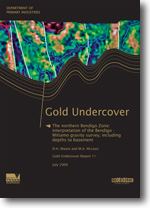GU Report 11 - The northern Bendigo Zone: interpretation of the Bendigo-Mitiamo gravity survey, including depths to basement
 |
| |||||||||||||||||||||||||||||
Product description:Introduction This report describes an interpretation of the results of a detailed ground gravity survey that was commissioned by GeoScience Victoria over the covered area of the Bendigo Zone to the north of the area of Palaeozoic outcrop. The survey was recorded in 2007 with the aim of providing data to aid mineral exploration in the area north of the major gold-producing region of Victoria, where some 2000 t of gold has been produced, most of it before 1914 (Phillips et al., 2003). Lisitsin et al. (2007) suggested that there is a 50% chance of the covered area containing another 990 t of gold. Despite this potential, there has been only a modest amount of exploration in the region and, consequently, few successes. The most important recent exploration successes were at Lockington, where Gold Fields Australasia Pty Ltd found gold mineralisation similar to that at Fosterville, and at Tandarra, where Leviathan Resources Ltd discovered mineralisation similar to that at Bendigo (Turner, 2007). Within the Bendigo Zone, these basement rocks are comprised of mildly deformed Ordovician turbidite sequences that were deformed in the Late Ordovician to Early Silurian (VandenBerg et al., 2000). The turbidite pile was subsequently intruded by Early to Middle Devonian granites (VandenBerg et al., 2000). The Murray Basin is a laterally extensive, circular shaped intracratonic basin containing thin flat lying Cainozoic sediments. It extends approximately 850 km from east to west and 750 km from north to south and covers an area of 300 000 km2 of western NSW, northwest Victoria and southeast South Australia (Brown & Stephenson, 1991). The Cainozoic sediments unconformably overlie Palaeozoic basement rocks in the northwestern region of Victoria. Throughout this report, the term ‘basement’ refers to Palaeozoic rocks unconformably underlying the Murray Basin Sediments. Within the northern Bendigo Zone, previous drilling has shown that prospective Palaeozoic rocks in some areas are much closer to the surface. Furthermore, previous mapping in areas of Palaeozoic outcrop to the south of the study area has shown that many of the major faults were reactivated during the Cainozoic, with reverse movements of tens of metres. Willman (2007) showed that the best mineralisation at both Bendigo and Castlemaine was found a few kilometres into the hanging walls of major faults. Thus, these areas of shallow cover are both prospective and easy to explore. Previously acquired gravity data (Steele et al., 1996) showed that more detailed gravity data would identify areas of thin cover (Moore et al., 2004). Seismic data (O’Shea, 2008) previous outcrop mapping, and metamorphic studies have all suggested that the vertical throws on some of the larger faults might be large enough to provide measurable changes in metamorphic grade across the faults (Offler et al., 1998). If so, these grade changes might be recognisable in gravity data. Another incentive to acquire detailed gravity data was the difficulty of interpretation of available airborne magnetic data. Although many of the granitic intrusions can be readily identified from aeromagnetic data, the magnetic responses from the Palaeozoic metasediments are either too weak to be effectively imaged or they are overprinted by responses from Pleistocene stream channels. Thus, acquisition of detailed gravity data was seen as a way to significantly upgrade regional geophysical interpretations of the area. Interpretations of the new detailed ground gravity data and estimates of the thickness of Murray Basin sediments in the northern part of the Bendigo Zone are presented in this report. Depth to the underlying Palaeozoic turbidite sequence (the host rock for many gold deposits in the Bendigo Zone) has been estimated by inversion using VPmg (Vertical Prism magnetic gravity) software. The geometry of our inversions was constrained by bore hole intersections with the interface between Murray Basin sediments and the underlying Palaeozoic turbidite sequence. We identified palaeochannels on enhanced gravity images and our interpretation of these features is supported by inversion modelling of the Murray Basin. Download The downloadable version of this report is supplied in PDF format. The borehole database used to determine depths to basement is also supplied (MS Excel format). Bibliographic reference Moore, D.H. & McLean, M.A., 2009. The northern Bendigo Zone: interpretation of the Bendigo-Mitiamo gravity survey, including depths to basement. GeoScience Victoria Gold Undercover Report 11. Department of Primary Industries. Related products:
| ||||||||||||||||||||||||||||||



